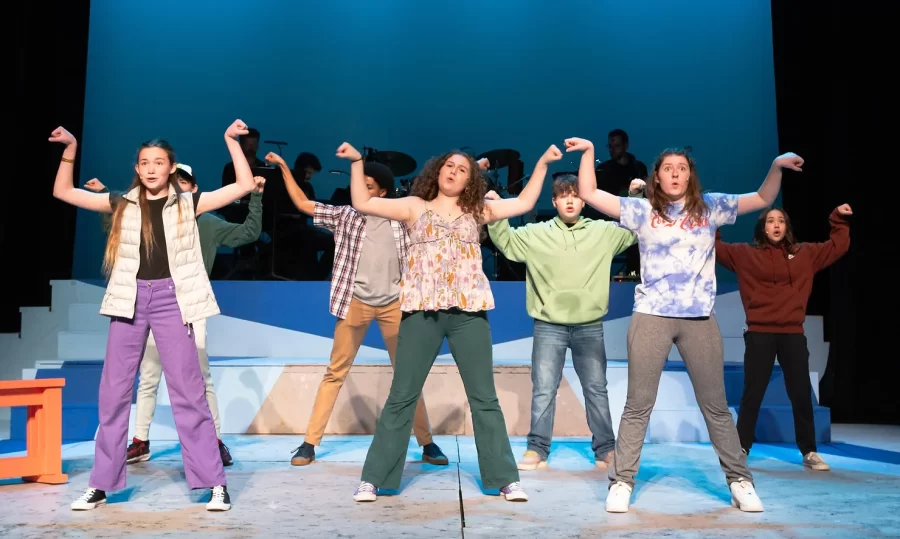CenterStage Adjusts to New Space under its New Director with “13: The Musical”
The cast of “13: The Musical” at CenterStage at the Trager Family JCC. Photo by Robyn Kaufman. Courtesy Trager Family JCC.
April 13, 2023
This story was originally published to Arts Angle Vantage April 2023.
Staging, rehearsing, and performing a musical is a formidable task in any circumstance, let alone one in which the space you have to work with is new and brings uncertainty with its unfamiliarity.
“We didn’t get our actual stage until probably the week before tech and so we had to work with kind of like a gymnasium floor so that was interesting,” said YPAS freshman Leilani Bracey (Lucy).
With music and lyrics by Jason Robert Brown and a book by Dan Elish and Robert Horn, “13” tells the story of a big-city Jewish boy as he navigates his life — currently consumed by his parents’ divorce, his upcoming Bar Mitzvah, and the new social environment in small-town Indiana.

This show was Silliman’s mainstage directorial debut. Silliman was heavily involved in performing arts throughout high school, including choir, dance, and musical theatre, and received two degrees in music education in college. She was an elementary music teacher for eight years until she was offered her first position at CenterStage in 2018 as their educational program coordinator. Last year, she was promoted to the organization’s Arts & Ideas director and planned their season.
For the direction of “13”, she chose to work with a cast entirely under the age of 18. This was CenterStage’s first large-scale production at the new JCC, which brought many challenges, as well as opportunities, to everyone involved.
Dancing, formations, and the use of set pieces are all important elements of a musical. But it can be difficult to adapt every step and every set change onto a new stage.
“The spacing was just a little weird because we didn’t know what our set was going to look like until later in the process, so we just had to figure out what we had to do to make sure everything looked OK,” Bracey said.

Unlike the stage in the old facilities, this new stage at the JCC is raised only a few inches off the ground and includes a set of built-in stairs. Silliman said this causes the placement of the musicians to be flexible, and for “13” she had the musicians sit at the top of the stage. This enabled the actors to move and dance in the way they had previously rehearsed.
In this unfamiliar space, technical issues were another factor.
“The lighting and sound are very different from our old space. Basically, all the electric is different. So, all the electric in the old space was on dimmers, they had capabilities that we don’t have here, and here everything is LED,” Silliman said. “We also don’t have the flexibility that we used to have. So, we can’t get in there and move all the lights around.”
For this production, “13” didn’t require a particularly extravagant set, with the entire show needing only a few set pieces. That worked with formation of the backstage.
“There was a really thin backstage on one side and then the white sheet, the [cyclorama], in the back, was like a small hallway and that’s how we crossed from each side,” Bracey said. “Then on the other side, it was bigger. That’s where we kept the benches that we used and there was a prop table.”

However, for future shows at CenterStage, the smaller backstage space may prove to be an obstacle to overcome. This could present challenges to using many larger-scale, and often fantastical, large set pieces, props, and costumes musicals incorporate to draw the audience into the world in which the story is being told.
Some consider the smaller auditorium a positive aspect of the new space, particularly in the case of “13.”
“It feels like everyone is closer together and it feels more intimate, and I like small theaters because you can see the audience and you can like see their reactions to the show and that’s really exciting to see when you’re on stage,” Bracey said.
As for CenterStage’s future in the new space, Silliman has planned next year’s season which was just announced. Through her position, she has learned all about budgeting, resourcefulness, and how she can respect what CenterStage has established and continue its legacy.
“The aim right now is to get back on our feet,” Silliman said, considering the closures through the pandemic and the move to a new building. “My goal is to continue forward, honoring what’s happened in the past, but also not being afraid to evolve.”


